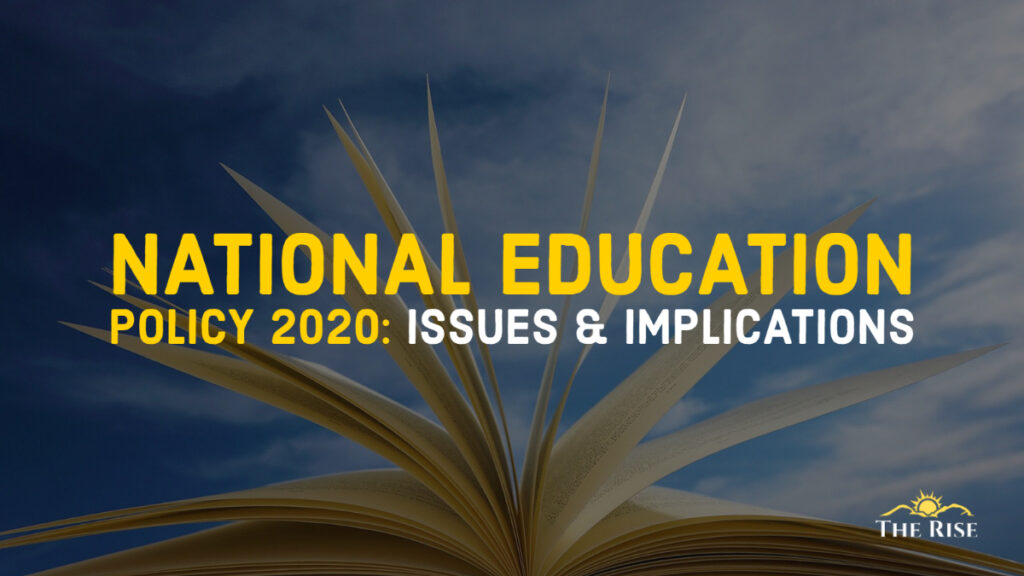With one year of the announcement of NEP 2020 nearing, it is high time for the details of implementation strategies to be announced.
The National Education Policy (NEP) 2020 asserts to have a system of higher education that is second to none in the entire world. We are already the single largest nation of higher education found anywhere in the world as far as the number of higher educational institutions is concerned. No other country has as many institutions as we do. In terms of enrolment, ours is the second largest system of higher education and even with the normal rate of growth in higher education enrolment, we would become the largest higher education system in 15-20 years. Taking the GER in higher education from the present 28 percent to 50 percent by 2035 is undoubtedly achievable, probably much more easily than might imagine.
The biggest push, therefore, has to come in the sphere of quality of excellence. We wouldn’t be regarded as second to any if most of our higher educational institutions become top-ranked and the top 100 list of the world-class higher education institutions are dominated by the Indian universities. This is going to be easier said than done as this shall require massive fusion of funds, focus on merit-based faculty selection & retention, and freedom to higher educational institutions; freedom not to do what they wish to do but freedom to do what they are expected to do. Challenging but not impossible.
NEP 2020 pitches for structural reforms in higher education for ensuring quality and promoting excellence in higher education. Recommendations in this regard include structural changes in the realm of higher educational institutions, higher educational programmes, governance, and regulation.
Also Read: New Education Policy 2020 – Implementation Challenges in Higher Education
NEP 2020 pitches for structural reforms in higher education for ensuring quality and promoting excellence in higher education.
With respect to the institutional restructuring, the policy seeks to abolish the affiliation system by reclassifying all higher educational institutions into three broad categories – research universities, teaching universities, and autonomous higher educational institutions. This means that nearly 49,000 colleges and stand-alone higher educational institutions would be freed from the shackles of the affiliating universities and would get the power to award degrees in their names.
In the process, universities would be freed from the affiliation and examination burden and would be in a better position to focus on their primary functions of teaching, research, and community engagement, usually referred to as an extension. The policy also aims at upsizing the higher educational institutions through, mergers, consolidation, and clustering with a view to make all higher educational institutions multi-disciplinary.
In the spheres of the academic programmes, the policy argues for a flexible curricular framework situated in a multi-disciplinary environment with wider choices to students to enable them to swim across the sea of disciplines to get a flavour of liberal art education and then to dive deep to specialise and super-specialise. NEP 2020 seeks to promote blended learning to ensure anywhere-anytime learning, making students autonomous in the choice of their course contents and programme duration.
Also Read: Blended Learning in Indian Higher Education: How Feasible is it?
NEP 2020 seeks to promote blended learning to ensure anywhere-anytime learning, making students autonomous in their choices.
It further seeks to promote seamless mobility not just across disciplines but also between the world of knowledge and the world of work. Students would be free to accumulate credits through the mode and from places of their preference and deposit them in the ‘Academic Bank of Credit (ABC)’ and get them converted into a diploma or degree kind of qualification from a recognised university. ‘ABC’ would work like a demat account with a depository that stock investors use to trade scrips. Alas! Unlike traders and investors, students would not have the option to exchange, exit, or encash their credits and qualifications. Irrespective of their value and worth, the students would remain saddled with their credits and qualifications and all the associated sunk cost. The free market provides people choices and the players are expected to exercise informed judgement.
Also Read: A View on Higher Education in New Education Policy 2020
The multiplicity of regulatory bodies is sought to be done away with within higher education except for the medical and agriculture education. A new generation body in the form and style of the national Higher Education Commission of India (HECI) has been visualised. Details of the HECI are still being worked out but what we know is that it shall have four verticals.
- Higher Education Regulatory Council (HERC) to take care of the entry, operation and exit of higher educational institutions;
- National Accreditation Council (NAC) to recognise and licence multiple agencies to accredit higher educational institutions and programmes with a consequence that the National Assessment and Accreditation Council (NAAC) and the National Board of Accreditation (NBA) shall loose their monopoly and shall have to compete with private players;
- General Education Council (GEC) to deal with broad policies and national framework for the development of higher education. All existing professional councils and regulatory bodies, including bodies like the All India Council for Technical Education (AICTE) are to become Professional and Academic Standard Setting Bodies (PASSB) and become a member of GEC to steer the policy agenda of higher education;
- Higher Education Grant Council (HEGC), which probably would be the transformation of the University Grants Commission (UGC).
You May Like: Scrutinizing the appointment of Vice-Chancellors
The policy asserts that the growth in higher education would come through the public as well as the private sector and insists that the private sector needs to be treated at par with the public sectors in the matters of regulation, governance, and funding. It hopes that the private higher educational institutions would be public-spiritedness in character. The policy provides freedom to institutions to accelerate cost recovery and user charges and to fix their fees.
The policy believes that this would not lead to commercialisation and profiteering in higher education; and If it does, it could be effectively taken care of through disclosure-based self-governance and regulation. Further, as per the policy, equity and inclusiveness could be ensured in higher education through liberal provisions for tuition waiver and scholarship. Where would the money come from? The policy hints at some public support. But given the contemporary experience of implementing fee-waiver policies implemented in the institutions of national importance, chances are that the additional burden would be met mainly through cross-subsidisation.
Also Read: 2020: A Year of Shambolic Education Burdening Learners
It has been a year since the NEP 2020 was announced and shall be due for the anniversary celebration on 29th July 2021. All policies must undergo the stages of formulation, notification, anatomization, modification, implementation, and, in between, celebration. It is now high time that the details are worked out and implementation strategies announced.
Disclaimer: The views expressed in this article are of the author solely. TheRise.co.in neither endorses nor is responsible for them.
About the author
Dr. Furqan Qamar is a former professor of management at Jamia Millia Islamia and an education advisor in the Planning Commission, now NITI Aayog, is currently the Chief Advisor to the Chancellor at Integral University, Lucknow. He has been the former Vice-Chancellor of the University of Rajasthan and Central University of Himachal Pradesh and Secretary General of Association of Indian Universities..










Pingback: NEP 2020- Issues and Implications – Furqan Qamar
Pingback: Anniversary-of-NEP-2020 - TheRise.co.in - Editor's Pick
Pingback: Quality Education: A Luxury or A Fundamental Right? - TheRise.co.in
Pingback: Regulations Impede Excellence in Higher Education - TheRise.co.in
Pingback: Importance of Teachers in Higher Education - TheRise.co.in